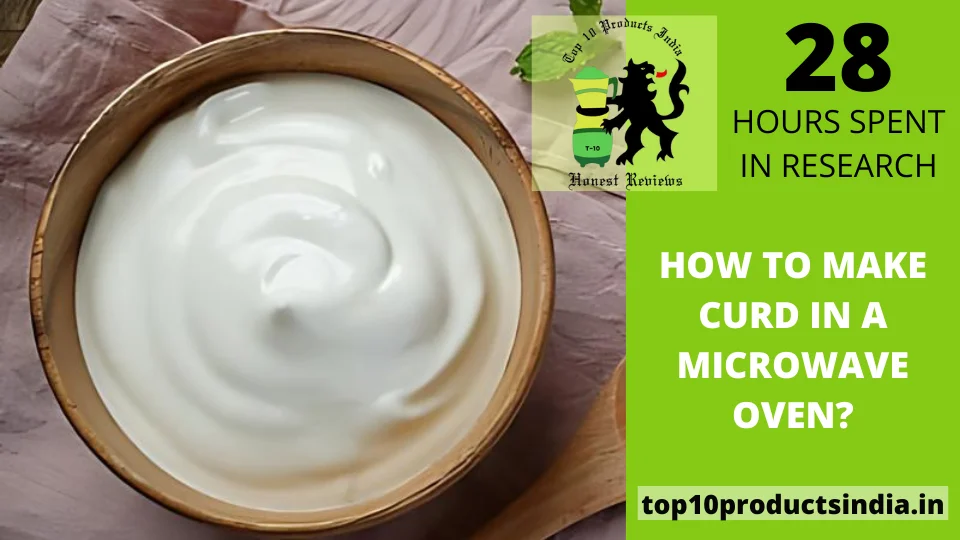Have you been wondering if it is possible to make a card in the comfort of your house or generally how to make a card in a microwave oven? In some parts of the world and in some cultures, it is called yoghurt, a dairy product that can be used for different reasons and in different recipes.
Many people love it for the sour taste and the richly creamy texture. It was a difficult process to make curd long ago because it needed para-disciplined attention, and large amounts of time were used in the process.
But thanks to technology, now we have been exposed to appliances that make the process ten times easier. In this blog, I am going to tell you everything that you need to know about making cards, all the tips that you need and everything you should do to make the final product a success.
Importance of Temperature and Time

Two of the vital things that you need to take note of while making curd are time and temperature. The temperature that you would want for making your curd is between 37 degrees Celsius to 46 degrees Celsius or 100 degrees Fahrenheit to 115 degrees Fahrenheit, depending on the type of appliance that you are using.
If you follow these instructions, it is going to be easier for the activity of enzymes to happen, and it is a very good place for bacteria growth to take place, and this does not alter the nature of the proteins.
Another thing that you should take note of is the duration of the fermentation. How much time it takes for the fermentation process will also determine what your curd will come out like at the end of the day.
The longer the fermentation, the thicker and the sour taste will be. The shorter the fermentation, the softer the mouth will taste.
Preparation and Equipment
This is basically the initial stage for what we are about to do: the curd-making process.
It is important for you to have all the ingredients and equipment that you need wherever you are going to make your curd. The first thing that you need is the milk that is of high quality.
Most of the time, I would suggest that you get fresh milk that will give you the creamiest result, especially if it is full of fat. You have to choose a microwave, and your container should be able to get into the microwave without causing any electrical problems. You also need a lid so that your milk does not spill.
Another thing that you need to take note of is that you should have to monitor the temperature using a thermometer that you can trust during the process. You are going to need a spoon or if you have a whisk that will be better for you while mixing the candy.
Step-by-Step Process
Heating the Milk:
You are the one who knows the amount of curd you are going to need at the end of the day. So, you pour the amount of milk you need into a container that can be put in the microwave without causing any electric shocks.
After doing that, you put the microwave on low temperatures and begin to stir the milk. Don’t do this in a hurried manner, but do it softly and gradually so that all the milk gets to the same temperature at the same time.
The temperature I would suggest for this first process would be around 43 degrees Celsius. It is not too hot, it is not too cold. You can even touch it.
Adding the Starter Culture:
Do not waste too much time. As soon as you see that the milk has reached the temperature that you are looking for, it is safe for you to add your starter curd. This can just be a very simple or clean yoghurt that you have in your house already, or you are going to buy it from the store.
After adding a teaspoon of that, you are going to gently mix that into your milk and continue mixing until you see that everything has been evenly distributed. Once you do that you will see that there will be a soft texture that begins to form.
Mixing and Covering:
Once you see that everything has been done well, put your milk in a lid or cover it with a microwave-safe cover to make sure that the heat does not escape from the milk. This is done so that the temperature is maintained in a stable way during the fermentation process, and you give the milk the last stir to make sure that everything has been blended well.
Microwave Settings and Timing:
You should set your microwave at the lowest point of power, around 50 to 60 per cent. I cannot really tell you the exact time you need because, at the end of the day, it all depends on the amount of heat that your microwave exerts, so to be safe, I’ll just say put four to six hours and this will also depend on the tightness that you need and also the tests and the preference of an individual will matter so you choose what works for you.
Tips for Success
The things that you should do to make sure that the end game of your card making process will be lit.
- Choose Fresh Milk: I always tell people and suggest going for fresh milk. They should be fresh from the farmer so that there are no preservatives in them.
- Maintain Cleanliness: You know when the things that you are using are dirty and contaminated, your curd will have undesirable flavours. These are the things that I would not want to have.
- Experiment with Cultures: You should look at how other people are making their curds and try to adjust as much as it works for you.
- Avoid Overheating: It is always important to monitor the temperature to which you are exposing your milk throughout the process.
Troubleshooting
These are the things that we do once we see any of these problems.
- Thin or Runny Curd: If you see that this is the problem, one of the things that you can do is increase the fermentation time. That’s the one you have already used. Or you could use a higher concentration of this data culture. The yoghurt that you had can add a little more.
- Curd Not Setting Properly: This is a problem that usually comes when the temperature is not ideal for the curd process. So, you have to adjust everything from the beginning and make sure that the temperature is right at each stage.
- Unpleasant Odor or Taste: I suggest that you just throw it away and start from the beginning. And this time I know you will have more experience than before.
Safety Precautions
These are the things that you should know to keep yourself safe. As much as you want the curd you would not want to end up the process with bruises and scars.
- Handle Hot Containers with Care: If you are taking in and out of the microwave container, it is always advisable to use kitchen towels, or even if you have oven gloves, you can go for that also so that you do not burn your hands.
- Avoid Contamination: Continue to sanitize the surfaces and the intensities that we are using throughout the process, and this will reduce the amount of contamination that will happen or even the bacteria that will come in contact with your milk.
- Monitor Temperature: This is a very important thing that needs to be taken off. Do not overheat it. I said before that you should use a thermometer and make sure that you can rely on that thermometer so that it does not lead you astray.
Comparison with Traditional Methods
There is always a little something to the way people long ago used to make cuts than we are right now, but as I have said, it has been a long process, a difficult and exhausting and
One. But because of the technology that we have, it has become easier to make, it saves power, it saves energy. So this can also be a good thing for our environment. So, while doing this, you need to know that as much as you want to go for the traditional method, the modern method will always help you and help the next person.
Serving Suggestions
These are the ways that you can eat your cut if you want to use it in different recipes. These are the few suggestions that I have for you.
- Enjoy Plain Curd: You can just eat the sour, creamy, and rich texture of your curd without adding anything to it, or you can just put a little bit of honey on it and have it for a snack while watching your television.
- Incorporate in Recipes: Curd can be used for marination. If you want to fry your chicken, you can use curd as a marinade. You can also use it for dressings, especially when making salads. So, there are a lot of things that you can do with curd that you would want to try.
- Pair with Complementary Flavors: What you can do is you don’t need to add curd to anything that does not go well with it. So these are the few ideas that I have that you might want to try. You can eat curd with fresh fruits. You can add herbs to it. You can eat curd with nuts, and this will create an unforgettable experience, and you might really want to try it.
Conclusion
To sum it all up, I have told you how to make curd, the things that you need to take note of, the tips that you might want to make the final thing a success and also how to solve some problems that may arise.
So by understanding everything, you would know that my curd would definitely come out the way I want it. So why not just go now and start gathering your ingredients, cleaning your kitchen and make sure you start making your curd right away.












